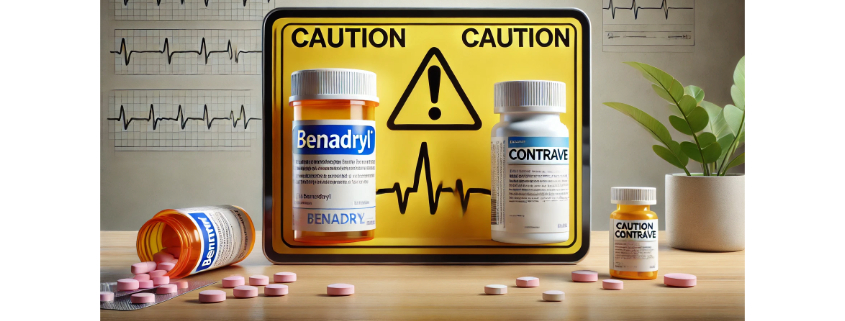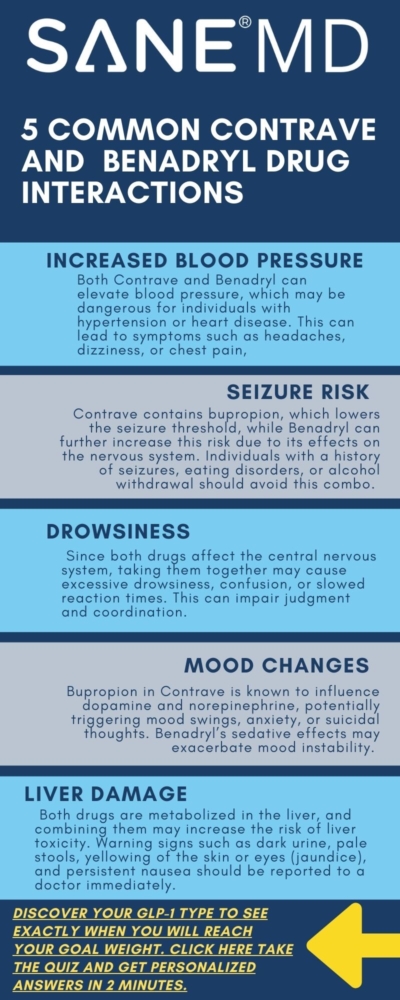Contrave and Benadryl Drug Interactions: Risks & Warnings
Dr. Matthew Olesiak, MD, is the Chief Medical Director at SANESolution, a renowned wellness technology company dedicated to providing evidence-based solutions for optimal living. Dr. Olesiak earned his medical degree from the prestigious Jagiellonian University Medical College in Kraków, Poland, where he developed a strong foundation in medicine.

Contrave is a prescribed medication for weight loss that combines bupropion and naltrexone to assist compatible individuals in shedding pounds. Benadryl, an over-the-counter antihistamine, is commonly used for allergies, cold symptoms, and sleep issues.
While both drugs serve different purposes, taking Contrave and Benadryl together can result in potentially dangerous drug interactions.
Anyone considering or currently taking Contrave treatment must understand Contrave and Benadryl drug interactions, side effects, and safety warnings.
Key Takeaways
- Combining Contrave and Benadryl may increase the risk of serious side effects, including increased blood pressure, seizures, and mood changes.
- Taking these medications together can lead to dangerous drug interactions, especially in individuals with eating disorders, heart disease, or a history of opioid use.
- Patients should consult their doctor or pharmacist before combining these medications to ensure safety.
How Contrave Works
Contrave is a prescription weight loss medication designed to help certain individuals with obesity or weight-related health conditions manage their weight more effectively.
How Contrave works for weight loss is unique. It combines two active ingredients, bupropion and naltrexone hydrochloride, each of which plays a distinct role in controlling appetite and cravings.
- Bupropion: Originally developed as an antidepressant, bupropion affects the brain’s neurotransmitters, particularly dopamine and norepinephrine. These neurotransmitters regulate mood, motivation, and energy levels, which can influence eating behaviors. Bupropion has also been used as a smoking cessation aid due to its impact on the brain’s reward system. However, it carries a risk of suicidal thoughts, especially in young adults, and can increase the risk of seizures in some individuals.
- Naltrexone Hydrochloride: This opioid antagonist is commonly used in the treatment of opioid dependence and alcohol dependence. In the context of weight loss, it works by blocking opioid receptors in the brain, which are linked to food cravings and emotional eating. By interfering with these reward pathways, naltrexone reduces the pleasure derived from high-calorie foods, making it easier for patients to stick to a healthy diet.
Contrave is a unique weight loss treatment because it combines bupropion and naltrexone hydrochloride. It targets both the psychological and physiological aspects of eating.
However, because of its effects on the brain and nervous system, Contrave comes with potential side effects, including high blood pressure, mood changes, and increased heart rate.
It is also not recommended for individuals with bipolar disorder, seizure disorders, or those taking opioid medications.
Since Contrave is metabolized in the liver, patients with liver damage should consult their doctor before starting treatment.
Additionally, taking high-fat meals while on Contrave can increase the absorption of the drug, potentially leading to stronger side effects.
Patients should tell their doctor about any other medications they are taking to avoid drug interactions that could increase risks or reduce the effectiveness of Contrave treatment.
Understanding Benadryl
Benadryl is an over-the-counter antihistamine widely used for allergy relief, cold symptoms, and as a sleep aid. Its active ingredient, diphenhydramine, is a first-generation antihistamine that works by blocking histamine receptors in the body.
Histamine is a chemical responsible for allergy symptoms such as runny nose, sneezing, watery eyes, and skin rash.
- How It Works: When the body encounters allergens such as pollen, pet dander, or dust mites, it releases histamine, which triggers inflammation and allergy symptoms. By preventing histamine from binding to its receptors, Benadryl reduces nasal congestion, itching, and swelling.
- Sleep Aid Properties: Diphenhydramine has sedative effects, making it a common ingredient in nighttime cold medications and over-the-counter sleep aids. It causes drowsiness by crossing the blood-brain barrier and blocking histamine’s effects in the central nervous system. This can be beneficial for those struggling with insomnia, but it also increases drowsiness, dizziness, and impaired motor coordination.
While Benadryl is generally safe for short-term use, long-term or frequent use can lead to side effects such as dry mouth, urinary retention, memory issues, and confusion. In older adults, prolonged use has been linked to cognitive decline and an increased risk of dementia.
It may also interact negatively with other medications, including opioid pain relievers, muscle relaxants, and alcohol, amplifying their sedative effects.
Patients with high blood pressure, heart disease, glaucoma, or asthma should consult their doctor before taking Benadryl, as it can worsen these conditions.
Additionally, combining Benadryl with other sedatives or central nervous system depressants, such as Contrave, can increase the risk of dizziness, confusion, and serious drowsiness.
Both Contrave and Benadryl affect the brain and nervous system, which is why taking them together should be done with caution and only under medical supervision.
Contrave and Benadryl Drug Interactions: Risks & Recommendations
| Interaction Factor | Effects | Risk Level | Recommendation |
|---|---|---|---|
| Seizure Risk | Both Contrave and Benadryl lower the seizure threshold, increasing risk. | High | Avoid combining if you have a seizure disorder or history of seizures. |
| Blood Pressure Changes | May cause high blood pressure or fluctuations, leading to cardiovascular issues. | Moderate to High | Monitor blood pressure closely; consult a doctor before use. |
| Mental Health Risks | Potential for mood changes, depression, panic attacks, and suicidal thoughts. | High | Patients with depression, bipolar disorder, or mood disorders should consult a doctor. |
| Blood Sugar Levels | May cause low blood sugar or sudden fluctuations, especially in diabetics. | Moderate | Diabetics should monitor blood sugar closely and discuss with a doctor. |
| Liver Damage | Both drugs are metabolized in the liver, increasing liver damage risk. | High | Patients with liver conditions should get routine liver function tests. |
| Allergic Reactions | Increases likelihood of serious allergic reactions, such as rash or anaphylaxis. | High | Seek immediate medical attention for rash, swelling, or breathing issues. |
| Cognitive Impairment | Can cause drowsiness, confusion, memory problems, and dizziness. | Moderate | Avoid activities requiring alertness; use caution in elderly patients. |
| Heart Health Risks | May contribute to irregular heartbeat, chest pain, or increased heart rate. | High | Heart patients should consult their doctor and monitor symptoms closely. |
| Impact on Weight Loss | Benadryl may counteract Contrave’s effects by increasing drowsiness and slowing metabolism. | Moderate to High | Consult a doctor before combining to ensure weight loss treatment remains effective. |
Potential Drug Interactions
Combining Contrave and Benadryl can lead to serious drug interactions, affecting blood pressure, mental health, and other critical functions.
Taking these medications together may increase the risk of seizures, cause mood changes, and affect cognitive abilities.
In addition to Benadryl, Contrave may also interact with other medications, such as antidepressants like Lexapro. Learn more about the potential risks of Contrave and Lexapro drug interactions in our comprehensive guide.
It’s crucial to inform your doctor about all the medications you are currently taking before beginning Contrave treatment.
Risk of Seizures
Both bupropion in Contrave and diphenhydramine in Benadryl can lower the seizure threshold, increasing the risk of seizures.
Individuals with a history of seizures, eating disorders, or alcohol use should avoid combining these medications.
Tell your doctor if you are at risk of seizures before taking Contrave.
Effects on Blood Pressure
Taking Contrave and Benadryl together may lead to high blood pressure or fluctuations in blood pressure levels. High blood pressure can increase the risk of heart disease, heart attack, or stroke.
Patients with preexisting heart disease or hypertension should consult their doctor immediately before using these medications.
Mental Health Risks
Combining Contrave and Benadryl may result in mood changes, depression, panic attacks, or even suicidal thoughts. Bupropion is known to affect mental health, and when combined with Benadryl, the risk of serious mental health side effects may increase.
Patients with a history of depression, bipolar disorder, or mood disorders should exercise caution and tell their doctor about any changes.
Impact on Blood Sugar Levels
Contrave can affect blood sugar levels, and individuals with diabetes should monitor their blood sugar closely when taking this medication.
Adding Benadryl to the mix may increase the risk of low blood sugar or sudden changes in blood sugar control.
Patients should discuss possible interactions with their healthcare provider.
Liver Damage and Gastrointestinal Issues
Both Contrave and Benadryl are metabolized in the liver, increasing the risk of liver damage. Symptoms such as dark urine, pale stools, or abdominal pain may indicate liver problems and should prompt medical attention.
Individuals with a history of liver issues should tell their doctor before starting treatment.
Allergic Reactions and Skin Reactions
Using Contrave and Benadryl together can increase the risk of serious allergic reactions, such as a skin rash, serious skin reactions, or Stevens-Johnson syndrome. Signs of a serious allergic reaction include swelling, difficulty breathing, or severe skin reactions.
Patients should seek medical attention if they experience these symptoms.
Cognitive and Neurological Effects
Combining these drugs can impair cognitive function, causing drowsiness, confusion, or impaired judgment. Patients should avoid driving or operating heavy machinery if they experience these side effects.
The risk of neurological issues increases if alcoholic beverages are consumed while taking these medications.
Effects on Heart Health
Taking Contrave and Benadryl together can increase the risk of an irregular heartbeat, high blood pressure, or chest pain.
Patients with heart disease should monitor for symptoms like chest pain or heart palpitations and consult a doctor immediately if they occur.
Impact on Weight Loss Treatment
Benadryl may counteract some of the weight loss effects of Contrave by increasing drowsiness and slowing metabolism. Patients taking Contrave for weight loss should avoid using Benadryl unless absolutely necessary.
It’s important to tell your doctor if you’re using over-the-counter medications while on Contrave treatment.
Risk of Opioid Withdrawal
Since Contrave contains naltrexone hydrochloride, patients using opioids or those with a history of opioid use should avoid combining it with Benadryl.
The combination could increase the risk of opioid withdrawal symptoms, leading to serious health risks.
Impact on Liver Function
Long-term use of Contrave and Benadryl can increase the risk of liver damage. Symptoms such as dark urine, pale stools, or abdominal pain should be reported to a doctor immediately.
Patients with liver conditions should undergo routine liver function tests.
Serious Skin Reactions
Combining these drugs may increase the risk of serious skin reactions. Symptoms include a severe skin rash, Stevens-Johnson syndrome, or other life-threatening skin conditions.
Patients should seek immediate medical attention if they experience signs of a serious skin reaction.
Symptoms Requiring Immediate Medical Attention
Patients taking Contrave and Benadryl should be aware of serious side effects that require immediate medical attention.
While some side effects may be mild or temporary, others can indicate a life-threatening reaction or severe complications that should not be ignored.

- Chest Pain: If you experience chest pain, tightness, or pressure, it could indicate a heart attack, irregular heartbeat, or high blood pressure complications. This is particularly concerning for individuals with a history of heart disease, high blood pressure, or cardiovascular issues. Seek emergency medical care if chest pain is severe or accompanied by shortness of breath, dizziness, or sweating.
- Severe Abdominal Pain: Persistent or intense abdominal pain may signal gastrointestinal issues, liver damage, or a serious allergic reaction. Patients taking Contrave should be especially cautious, as naltrexone hydrochloride can affect liver function, increasing the risk of liver inflammation or damage.
- Dark Urine and Pale Stools: These symptoms may indicate liver dysfunction, gallbladder disease, or bile duct obstruction. Since both Contrave and Benadryl are processed through the liver, their combined use may increase the risk of liver damage over time. If you notice dark urine, pale stools, or yellowing of the skin or eyes (jaundice), seek medical attention immediately.
- Serious Allergic Reaction: Symptoms of a serious allergic reaction (anaphylaxis) can include swelling of the face, lips, tongue, or throat, difficulty breathing, hives, and a severe skin rash. Anaphylaxis is a life-threatening condition that requires immediate emergency care. Individuals with a history of allergic reactions to medications should be particularly cautious when taking Contrave and Benadryl together.
If you experience sudden changes in health while taking these medications, do not wait—contact a doctor immediately or seek emergency medical care.
Side Effects to Watch
While Contrave and Benadryl are effective for their intended uses, combining them may lead to side effects that impact physical and mental well-being.
These can range from mild discomfort to serious health risks requiring medical intervention.
Common Side Effects
- Drowsiness and Dizziness: Since both Benadryl and Contrave affect the central nervous system, they can cause excessive drowsiness, dizziness, and impaired coordination. This increases the risk of falls, accidents, and difficulty performing daily tasks.
- Dry Mouth and Dehydration: Diphenhydramine in Benadryl and bupropion in Contrave can lead to dry mouth, making it uncomfortable to eat or speak. Staying hydrated and using sugar-free lozenges may help alleviate this symptom.
- Joint Pain and Muscle Aches: Some patients report joint pain or muscle discomfort when taking Contrave. This may worsen when combined with Benadryl, especially in individuals prone to chronic pain or inflammatory conditions.
- Cognitive Impairment: Confusion, memory problems, and difficulty concentrating are possible when taking these medications together. Older adults should be particularly cautious, as long-term Benadryl use has been linked to cognitive decline and an increased risk of dementia.
Serious Side Effects
- Suicidal Thoughts or Mood Changes: Bupropion, one of the active ingredients in Contrave, can increase the risk of suicidal thoughts, mood swings, and depression, particularly in young adults. Combining it with Benadryl may exacerbate mood disturbances, anxiety, or panic attacks. If you experience suicidal thoughts, sudden changes in mood, or worsening depression, contact a doctor immediately.
- Liver Damage: Since both medications are processed in the liver, their combined use may increase the risk of liver toxicity. Symptoms such as dark urine, pale stools, fatigue, nausea, and jaundice may indicate liver damage and require prompt medical evaluation.
- Irregular Heartbeat and High Blood Pressure: Patients with high blood pressure, heart disease, or a history of cardiovascular conditions should be particularly careful, as Contrave can increase blood pressure and heart rate. Taking Benadryl may further contribute to irregular heartbeat, palpitations, or chest discomfort. If you notice any unusual heart symptoms, seek medical attention.
When to Contact a Doctor
If you experience any persistent or worsening Contrave side effects, it is essential to tell your doctor as soon as possible. Always consult a doctor or pharmacist before taking new medications to prevent possible interactions and increased risk of severe complications.
FAQ: Contrave and Benadryl Drug Interactions
Understanding the possible interactions between Contrave and other medications, including Benadryl, is essential for ensuring safety and effectiveness. Certain drug combinations can lead to serious side effects, including increased risk of seizures, cardiovascular issues, and mood disturbances.
Below are answers to commonly asked questions regarding Contrave, Benadryl, and their potential interactions.
1. What medications should not be taken with Contrave?
Several medications should be avoided while taking Contrave due to potential Contrave drug interactions. These include monoamine oxidase inhibitors (MAOIs), which can increase the risk of high blood pressure and serotonin syndrome if taken within 14 days of starting Contrave.
Opioid medications should also be avoided, as Contrave contains naltrexone, an opioid antagonist that can cause withdrawal symptoms. Additionally, other medications that lower the seizure threshold, such as antipsychotics, certain antidepressants, and corticosteroids, may increase the risk of seizures.
Always tell your doctor about any medications you are taking before starting Contrave treatment.
2. Can I take Benadryl while on buPROPion?
It is generally not recommended to take Benadryl while on buPROPion, as both drugs can lower the seizure threshold, increasing the risk of seizures.
Diphenhydramine, the active ingredient in Benadryl, may also cause drowsiness and cognitive impairment, which can be exacerbated when taken with buPROPion. Additionally, both medications may affect mood and mental health, potentially leading to an increased risk of panic attacks or mood swings.
If you need an antihistamine while taking buPROPion, consult your doctor or pharmacist for a safer alternative.
3. What drugs interact badly with Benadryl?
Benadryl can interact negatively with several medications, including sedatives, muscle relaxants, and other central nervous system depressants, leading to excessive drowsiness and impaired coordination. It can also interact with monoamine oxidase inhibitors (MAOIs), increasing the risk of high blood pressure and other side effects.
Taking Benadryl with other medications that have anticholinergic effects, such as certain antidepressants and bladder medications, can increase the risk of dry mouth, urinary retention, and confusion.
People with heart disease or high blood pressure should also exercise caution, as Benadryl may cause irregular heartbeat or increased blood pressure.
Always consult a healthcare provider before combining Benadryl with other medications.
4. Does naltrexone block Benadryl?
Naltrexone does not block the effects of Benadryl. Naltrexone is an opioid antagonist that primarily affects opioid receptors, whereas Benadryl (diphenhydramine) is an antihistamine that works on histamine receptors.
However, both medications can affect the central nervous system, potentially leading to increased drowsiness or dizziness when taken together.
Although naltrexone does not interfere with the effectiveness of Benadryl, individuals taking Contrave, which contains naltrexone, should still consult their doctor before using Benadryl to avoid potential interactions or heightened side effects.
5. What medications should not be taken with Contrave?
Contrave should not be taken with opioid medications, as it contains naltrexone, which can block opioid effects and lead to withdrawal symptoms in individuals dependent on opioids. Therefore, Contrave and Oxycodone drug interactions can be dangerous, so you should never take them together unless directed to do so by your healthcare provider.
Additionally, medications that lower the seizure threshold, such as certain antidepressants (e.g., SSRIs, SNRIs, tricyclics), stimulants, and antipsychotics, may increase the risk of seizures when combined with Contrave.
High-fat meals should also be avoided, as they can increase the absorption of Contrave, potentially leading to stronger side effects.
Always tell your doctor about any prescription, over-the-counter, or herbal medications you are taking before starting Contrave treatment.
Conclusion
Combining Contrave and Benadryl can lead to serious health risks, including seizures, high blood pressure, and severe allergic reactions.
Patients should tell their doctor or pharmacist about all medications they are taking before starting Contrave treatment. Monitoring for side effects and consulting a healthcare provider for medical guidance is essential to ensure safety.
By understanding the risks and warnings associated with Contrave and Benadryl drug interactions, individuals can make informed decisions about their treatment options and minimize the risk of life-threatening complications.






